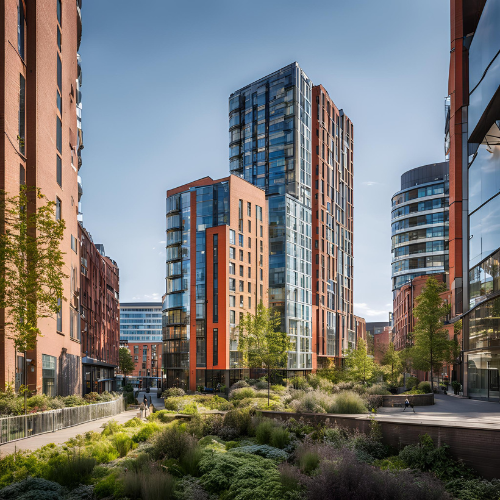Leeds Property Investment Trends 2025: Emerging Opportunities and Market Insights

Leeds continues to cement its reputation as one of the UK’s top property investment destinations. With a thriving economy, a growing population and strong rental demand, the city offers plenty of opportunities for investors.
In 2025, key trends such as student housing, eco-friendly developments, short-term rentals and build-to-rent models are shaping the market. This guide explores these trends and highlights the best investment opportunities landlords should keep in mind for the year ahead.
-
Why Leeds Is a Hotspot for Property Investment in 2025
Leeds has experienced significant economic and property market growth in recent years. In the 12 months leading up to March 2024, the city saw the construction of 4,441 homes, marking the highest level of housing delivery since the early 1980s and surpassing local targets by 35%.
The city’s population is also on the rise. Projections indicate an increase of approximately 19,647 households between 2022 and 2040, reflecting a growing demand for housing. This rising demand presents a valuable opportunity for landlords, as more households entering the market can lead to higher occupancy rates and competitive rental yields.
Rental demand remains robust. As of December 2024, the average monthly private rent in Leeds was £1,097, a 3% increase from £1,065 in December 2023. Specifically, rents for flats or maisonettes rose by 3.5%, while detached properties saw a 2.5% increase.
Leeds also stands out as a leading city for student housing, supported by its prominent universities and a substantial student population. The city’s housing strategy focused on the development of affordable and sustainable homes, aiming to meet the needs of its diverse residents.
For landlords, Leeds presents a strong investment opportunity with rising rental demand, a growing population and increasing property values. With a thriving student market and government-backed sustainable housing initiatives, it remains a high-yield, future-proof location for property investors.
Read more about buy-to-let opportunities in Leeds.
2. Economic Growth and Infrastructure Development
Ongoing urban development projects are significantly shaping Leeds property investment 2025. Here are some of the key projects and trends you need to know:
South Bank Leeds
- Covering 253 hectares—equivalent to 350 football pitches—this project aims to double the size of Leeds city centre. It’s set to deliver over 8,000 homes and create more than 35,000 jobs, significantly enhancing the city’s economic landscape.
- The regeneration includes the development of Aire Park, a 22-acre site that will feature 950 homes upon completion, contributing to the city’s housing supply.
- Planning Approvals: Recently, a proposed apartment development aimed at supporting the broader regeneration of the South Bank received a recommendation for approval. This project is set to be reviewed by councillors shortly.
- Future Developments: The project is poised to advance with further residential and commercial construction, infrastructure improvements and the creation of public spaces. A key focus will be on enhancing connectivity between the South Bank and Leeds city centre, as well as developing amenities to attract businesses and residents.
Read more about Leeds’ South Bank project.
Digital Infrastructure Investments
Since 2018, Leeds has invested over £750 million in transport upgrades, including Park and Ride facilities and improvements to bus services. The city’s Connecting Leeds Transport Strategy aims to make walking and cycling the first choice for short trips, enhancing overall connectivity.
Leeds’ £750 million transport investment isn’t just about infrastructure—it’s reshaping how people live, work, and move around the city. For landlords, this has direct implications on tenant demand, property values, and rental yields. Here’s why:
- Attracting young professionals and commuters
Better transport links mean shorter, more reliable commutes. With expanded Park & Ride facilities and improved bus networks, tenants working in the city centre but living in suburban areas like LS9, LS10, and LS12 will find these locations more appealing.
Public transport improvements also reduce reliance on cars, making properties with little or no parking more viable, particularly for city-centre flats and new-build developments.
- Boosting demand for sustainable and car-free living
The Connecting Leeds Transport Strategy prioritises cycling and walking infrastructure, making the city more attractive to young professionals, students, and digital nomads. Areas with strong pedestrian and cycling networks, such as South Bank and Aire Park, will see increased demand from renters looking for sustainable living options.
- Increasing appeal for students and low-cost renters
Many students and budget-conscious renters prefer locations with good public transport links over car ownership. Improved bus services strengthen connections between universities and key residential areas like Headingley, Hyde Parkand Kirkstall, making buy-to-let properties in these locations even more attractive.
Faster, more reliable travel to universities and workplaces further enhances rental appeal for properties near bus routes and Park & Ride facilities.
- Supporting the growth of hybrid and remote working
While commuting remains important, improved transport infrastructure allows for greater flexibility. Professionals who work remotely part-time but need office access may favour areas with reliable transport links over city-centre living.
This could boost demand in locations just outside Leeds, where rents are lower but connectivity remains strong.
Aire Park Development
Once completed in 2025, Aire Park will create a mixed-use community with 1,400 new homes, Grade A office spaces, retail and the UK’s largest new city centre park, making South Bank a prime location for both residents and businesses. For landlords, this means higher rental demand and property value growth, particularly in LS10, as the area becomes a sought-after destination for professionals, families, and tenants seeking modern, well-connected urban living.
- Aire Park is a planned 24-acre mixed-use development in Hunslet, south of Leeds city centre. The project includes 8 acres of parkland, 1,400 new homes, and nearly 1 million square feet of commercial space.
- The development retains historical sites like The Tetley Art Gallery and Salem Chapel. It aims to revitalise a previously underutilised area, effectively extending the city centre southwards.
- Impact on Property Market: The creation of new residential and commercial spaces is expected to increase property values and rental demand in the LS10 postcode, contributing to the overall economic growth of Leeds.
Phase One: Nearing Completion
- The initial phase includes the construction of two commercial buildings, 1 and 3 South Brook Street, offering a combined 190,000 square feet of Grade A office space. These buildings are set to launch soon, with tenant announcements anticipated in the near future.
Phase Two: Planning and Development
- Plans for the second phase were revealed in March 2024, aiming to expand the site across Crown Point Road. This phase is set to deliver over 1 million square feet of mixed-use office, retail, leisure, and commercial space, along with 1,400 modern homes.
Final Phase: Submission and Future Plans
- In July 2024, a planning application for the final phase was submitted. This phase focuses on creating the UK’s largest new city centre park, introducing 700 new trees, public exercise routes, and flexible spaces for outdoor events. The park’s completion is targeted for 2025.
3. Key Post Codes to keep in mind for 2025
As Leeds real estate trends 2025 continue to evolve, certain postcodes are emerging as key areas for growth and investment. From bustling student hubs to up-and-coming residential neighbourhoods, these locations offer promising opportunities for investors seeking strong returns in the year ahead.
LS9 – Regeneration and affordability
LS9 is benefiting from South Bank’s expansion, increasing demand for rentals near the city centre. With affordable property prices compared to neighbouring areas, it attracts young professionals and first-time renters priced out of central Leeds. Improvements in transport and local amenities make it a strong buy-to-let location with potential for long-term capital growth.
LS10 – South Bank transformation and business growth
LS10 is at the heart of major regeneration projects, including Aire Park and the South Bank expansion, bringing new housing, offices, and leisure spaces. As a result, demand for rental properties is rising, particularly from professionals working in the city centre. With property values expected to increase, landlords can capitalise on rising rental yields and long-term investment growth.
LS12 – Connectivity and rising demand
LS12 benefits from improved transport links and proximity to major employment hubs, making it attractive to commuters and families looking for more space at reasonable prices. Developments in infrastructure and public transport are driving higher tenant demand, especially for modern apartments and family homes, making it a solid choice for landlords seeking strong rental returns.
Here are 10 more reasons to consider investing in property in Leeds.
4. Green and Sustainable Housing Trends in Leeds
Leeds property investment 2025 is set to benefit from a growing demand for green and sustainable housing, as eco-conscious buyers and renters seek energy-efficient, low-carbon homes. From solar panels to smart insulation, these trends reflect the city’s commitment to a more sustainable future while offering attractive opportunities for investors.
Rising Popularity of Eco-Friendly and Energy-Efficient Homes
- More homebuyers and renters in Leeds are prioritising low-energy properties to cut energy costs and reduce their carbon footprint. With rising energy bills and awareness of climate change, tenants are actively seeking homes with better insulation, solar panels and energy-efficient heating systems. For landlords, investing in eco-friendly properties can attract long-term tenants, reduce void periods, and increase rental value as demand for sustainable living grows.
Examples of Green Developments in Leeds
- Climate Innovation District – A project by Citu transforming a brownfield site into a sustainable, mixed-use neighbourhood with 516 low-energy homes. The homes use modern timber-framed construction, triple glazing, and mechanical ventilation heat recovery systems to cut carbon emissions by up to 90% compared to standard homes. For landlords, this development presents an opportunity to invest in a high-demand area with strong tenant appeal due to its sustainability credentials and proximity to the city centre.
- Greenhouse Development – A low-carbon mixed-use development setting new standards for sustainable living in the UK. The scheme integrates renewable energy sources such as solar panels and ground-source heating, achieving a 60% reduction in carbon emissions compared to traditional housing. Properties within this development command premium rents due to their energy efficiency, making them an attractive option for landlords looking for long-term, stable rental income.
- LILAC (Low Impact Living Affordable Community) – A co-housing development in Bramley featuring 20 eco-friendly homes built using sustainable materials. The project follows a mutual homeownership model, keeping housing costs predictable and affordable while reducing the environmental impact. For landlords, this showcases the growing market demand for cooperative and sustainable living spaces, which could influence future investment strategies in shared ownership or eco-friendly housing.
Government Incentives for Sustainable Housing in 2025
- Warm Homes: Provides funding for energy performance upgrades and low-carbon heating systems for low-income households in England. This scheme allows landlords with eligible properties to receive grants for improving insulation, installing heat pumps, or switching to renewable energy sources. Investing in energy-efficient upgrades not only reduces tenant energy bills, making properties more attractive but also futureproofs rental investments against stricter environmental regulations.
- Warm Homes Plan – A £6.6 billion government initiative to improve five million homes with grants and low-interest loans for insulation, solar panels, and heat pumps. As energy efficiency regulations tighten, landlords who take advantage of these incentives can enhance their properties’ EPC ratings, avoiding potential fines and improving marketability. Higher-rated properties will not only meet legal requirements but also command higher rents, as tenants increasingly prioritise energy-efficient homes.
5. Student Housing Opportunities in Leeds
Leeds has seen a steady increase in its student population, with both the University of Leeds and Leeds Beckett University reporting higher enrolments in recent years.
This growth has led to increased demand for student accommodation, particularly in purpose-built student housing (PBSA) and HMOs (houses in multiple occupation). For landlords, this trend presents an opportunity to invest in or upgrade properties to meet rising demand, ensuring higher occupancy rates and consistent rental yields.
Comparison of Prime Student Neighbourhoods: Headingley, Hyde Park, and Kirkstall
Leeds property investment 2025 presents promising opportunities in prime student neighbourhoods like Headingley, Hyde Park and Kirkstall, each offering unique advantages for investors. While Hyde Park remains the social hub with high rental demand, Headingley appeals to those seeking a more suburban feel, and Kirkstall is gaining popularity with its affordable rents and strong transport links.
Headingley
If you’re looking for best Leeds neighbourhoods, located 20 minutes by bus from the city centre, Headingley is one of the city’s most popular student areas due to its lively town centre, independent shops, bars, and close proximity to Leeds Beckett University.
The area offers a mix of Victorian terraces, semi-detached houses, and PBSA, making it a prime location for student housing Leeds rentals.
Leeds rental yields in Headingley (LS6) average 7.9%, making it an attractive investment option, while house prices in Leeds have risen 55% in the past decade, with a further 21% increase predicted by 2026.
Hyde Park
Just a 20-minute walk from the city centre, Hyde Park is a student favourite thanks to its proximity to the University of Leeds and its vibrant community. The area is dominated by Victorian terraces, many converted into HMOs, providing high-yield rental opportunities for landlords.
The LS6 postcode, which includes Hyde Park, also sees strong rental yields of 7.9%, while house prices in the area have increased by 49% since 2011, indicating strong capital growth potential.
Kirkstall
Roughly 2 miles from the city centre, Kirkstall is a quieter, more affordable alternative for students who prefer a peaceful living environment. The area is well-connected by public transport and offers good access to supermarkets, gyms and green spaces.
While Kirkstall (LS5 postcode) has a slightly lower average rental yield of 5.6%, house prices are growing steadily, making it an affordable entry point for landlords looking for long-term appreciation and stable rental demand.
Tips for Maximising Returns from Student-Focused Investments
- Modern Upgrades – Adding features like high-speed internet, modern kitchens, and energy-efficient appliances makes properties more desirable, allowing landlords to charge premium rents. In competitive student areas like Headingley and Hyde Park, well-maintained, fully furnished properties consistently attract tenants faster and retain higher occupancy rates.
- Flexible Lease Terms – Offering short-term contracts for international students or all-inclusive rent packages can help properties stand out in a crowded market. Given the increasing number of international students coming to Leeds, providing flexible rental options can reduce void periods and ensure a consistent income stream.
- Strategic Location – Investing in properties within walking distance of universities, transport links, and key amenities like supermarkets and nightlife increases demand. Areas with high student footfall, such as Hyde Park and Headingley, consistently achieve yields above 7%, while more affordable options like Kirkstall still offer strong rental demand due to its connectivity and lower property prices.
By focusing on high-demand student areas and applying the right investment strategies, landlords can maximise both rental income and long-term property value in Leeds’ thriving student housing market.
Read more about student rental opportunities in Leeds
Short-Term Rentals and Leeds Tourism
Leeds has seen a notable increase in demand for short-term rental properties, driven by a rise in tourism and business travel. As of September 2024, the city had 1,631 active Airbnb listings, with a median occupancy rate of 61% and an average daily rate of £93, resulting in an average annual host income of £20,000.
Investors have identified areas such as Holbeck Urban Village and Chapel Allerton as hotspots for short-term rentals due to their popularity among visitors.
While short-term rentals offer benefits like higher rental yields and flexibility, they also come with challenges, including the need for active property management and potential regulatory changes.
Buy-to-Let Leeds vs. Build-to-Rent Leeds Investments
In 2025, the property investment landscape in Leeds presents distinct opportunities and considerations for both buy-to-let (BTL) and build-to-rent (BTR) models. BTL investments, traditionally favoured by individual landlords, involve purchasing properties to rent out to tenants.
- BTL
This model offers flexibility, allowing investors to choose property types and locations that align with their strategies. However, recent regulatory changes and economic factors, such as increased interest rates and stricter lending criteria, have posed challenges for BTL investors. Despite these hurdles, Leeds remains an attractive market due to its strong rental demand, driven by a growing population and a thriving economy.
BTR developments are large-scale residential projects designed specifically for rental purposes, often managed by institutional investors. These developments offer amenities like gyms, communal spaces and professional management services, appealing to tenants seeking a comprehensive living experience.
- BTR
In urban areas like Leeds city centre, BTR projects have gained traction, catering to young professionals and students. The advantages of BTR include economies of scale, consistent rental income, and the ability to meet modern tenant expectations.
However, they require substantial capital investment and are subject to market risks associated with large developments. For investors considering long-term goals, BTL may offer more control and lower entry costs, while BTR provides the potential for higher returns through scale but with increased complexity and investment requirements.
From the transformation of South Bank to the growing demand for student housing and sustainable developments, Leeds remains a resilient and attractive market. Landlords who stay informed about these trends can position themselves for strong returns in the year ahead. With the right strategies, Leeds offers a promising landscape for both short- and long-term property investments in 2025. To find out more about investing in Leeds, get in touch with our property experts.

